ignition NISSAN QUEST 2002 V41 / 2.G Owners Manual
[x] Cancel search | Manufacturer: NISSAN, Model Year: 2002, Model line: QUEST, Model: NISSAN QUEST 2002 V41 / 2.GPages: 294, PDF Size: 2.49 MB
Page 38 of 294
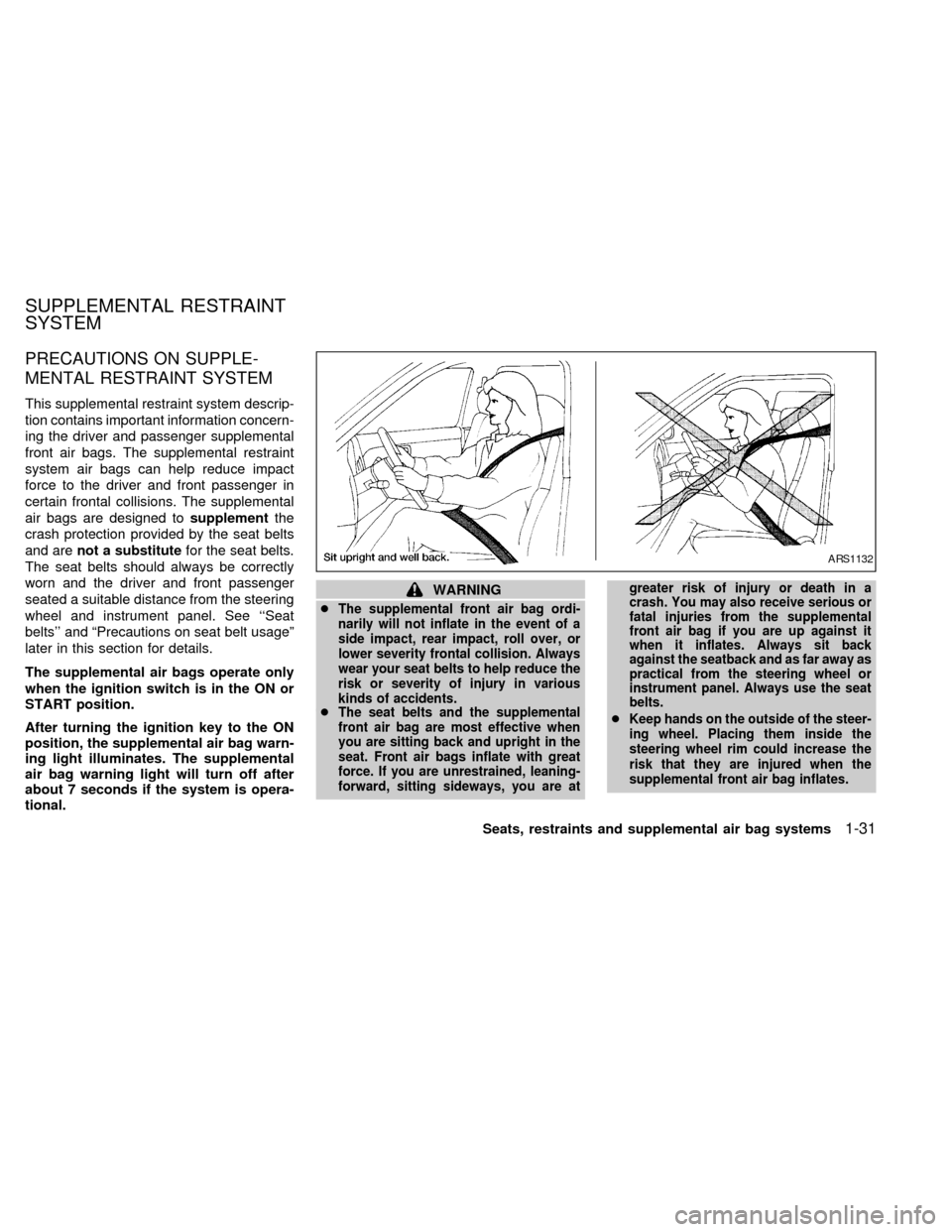
PRECAUTIONS ON SUPPLE-
MENTAL RESTRAINT SYSTEM
This supplemental restraint system descrip-
tion contains important information concern-
ing the driver and passenger supplemental
front air bags. The supplemental restraint
system air bags can help reduce impact
force to the driver and front passenger in
certain frontal collisions. The supplemental
air bags are designed tosupplementthe
crash protection provided by the seat belts
and arenot a substitutefor the seat belts.
The seat belts should always be correctly
worn and the driver and front passenger
seated a suitable distance from the steering
wheel and instrument panel. See ``Seat
belts'' and ªPrecautions on seat belt usageº
later in this section for details.
The supplemental air bags operate only
when the ignition switch is in the ON or
START position.
After turning the ignition key to the ON
position, the supplemental air bag warn-
ing light illuminates. The supplemental
air bag warning light will turn off after
about 7 seconds if the system is opera-
tional.
WARNING
c
The supplemental front air bag ordi-
narily will not inflate in the event of a
side impact, rear impact, roll over, or
lower severity frontal collision. Always
wear your seat belts to help reduce the
risk or severity of injury in various
kinds of accidents.
cThe seat belts and the supplemental
front air bag are most effective when
you are sitting back and upright in the
seat. Front air bags inflate with great
force. If you are unrestrained, leaning-
forward, sitting sideways, you are atgreater risk of injury or death in a
crash. You may also receive serious or
fatal injuries from the supplemental
front air bag if you are up against it
when it inflates. Always sit back
against the seatback and as far away as
practical from the steering wheel or
instrument panel. Always use the seat
belts.cKeep hands on the outside of the steer-
ing wheel. Placing them inside the
steering wheel rim could increase the
risk that they are injured when the
supplemental front air bag inflates.
ARS1132
SUPPLEMENTAL RESTRAINT
SYSTEM
Seats, restraints and supplemental air bag systems1-31
ZX
Page 41 of 294

Supplemental front air bag system
The driver supplemental air bag is located in
the center of the steering wheel. The front
passenger supplemental air bag is mounted in
the dashboard above the glove box.
These systems are designed to meet optional
certification requirements under U.S. regula-
tions. They are also permitted in Canada. The
optional certification allows front air bags to
be designed to inflate somewhat less force-
fully than previously.However, all of the
information, cautions and warnings in this
manual still apply and must be followed.
The supplemental front air bag system is
designed to inflate in higher severity frontal
collisions, although it may inflate if the forces
in another type of collision are similar to those
of a higher severity frontal impact. It may not
inflate in certain frontal collisions. Vehicle
damage (or lack of it) is not always an indica-
tion of proper supplemental air bag system
operation.
When the supplemental front air bag in-
flates, a fairly loud noise may be heard,
followed by the release of smoke. This
smoke is not harmful and does not indicate
a fire. Care should be taken to not intention-ally inhale it, as it may cause irritation and
choking. Those with a history of a breathing
condition should get fresh air promptly.
The supplemental front air bags, along with
the use of seat belts, help to cushion the
impact force on the face and chest of the
occupant. They can help save lives and
reduce serious injuries. However, an inflat-
ing front air bag may cause facial abrasions
or other injuries. Front air bags do not
provide restraint to the lower body.
Seat belts should be correctly worn and the
driver and passenger seated upright as far
away as practical from the steering wheel or
instrument panel. The supplemental front air
bag inflates quickly in order to help protect
the front occupants. Because of this, the
force of the front air bag inflating can in-
crease the risk of injury if the occupant is too
close to, or is against, the air bag module
during inflation.The air bag deflates quickly
after a collision.
The supplemental air bags operate only
when the ignition switch is in the ON or
START position.
After turning the ignition key to the ON
position, the supplemental air bag warn-
WRS0075
1-34Seats, restraints and supplemental air bag systems
ZX
Page 44 of 294

SUPPLEMENTAL AIR BAG
WARNING LABELS
Warning labels about the supplemental air
bag system are placed in the vehicle as
shown in the illustration.
SUPPLEMENTAL AIR BAG
WARNING LIGHT
The supplemental air bag warning light,
displaying
in the instrument panel,
monitors the circuits of the supplemental air
bag and pretensioner systems. The circuits
monitored by the air bag warning light in-
clude the diagnosis sensor unit, supplemen-
tal air bag modules, pre-tensioner seat belt
system and all related wiring.
When the ignition key is in the ON or START
position, the supplemental air bag warning
light illuminates for about 7 seconds and
ARS1123WRS0090
Seats, restraints and supplemental air bag systems1-37
ZX
Page 45 of 294
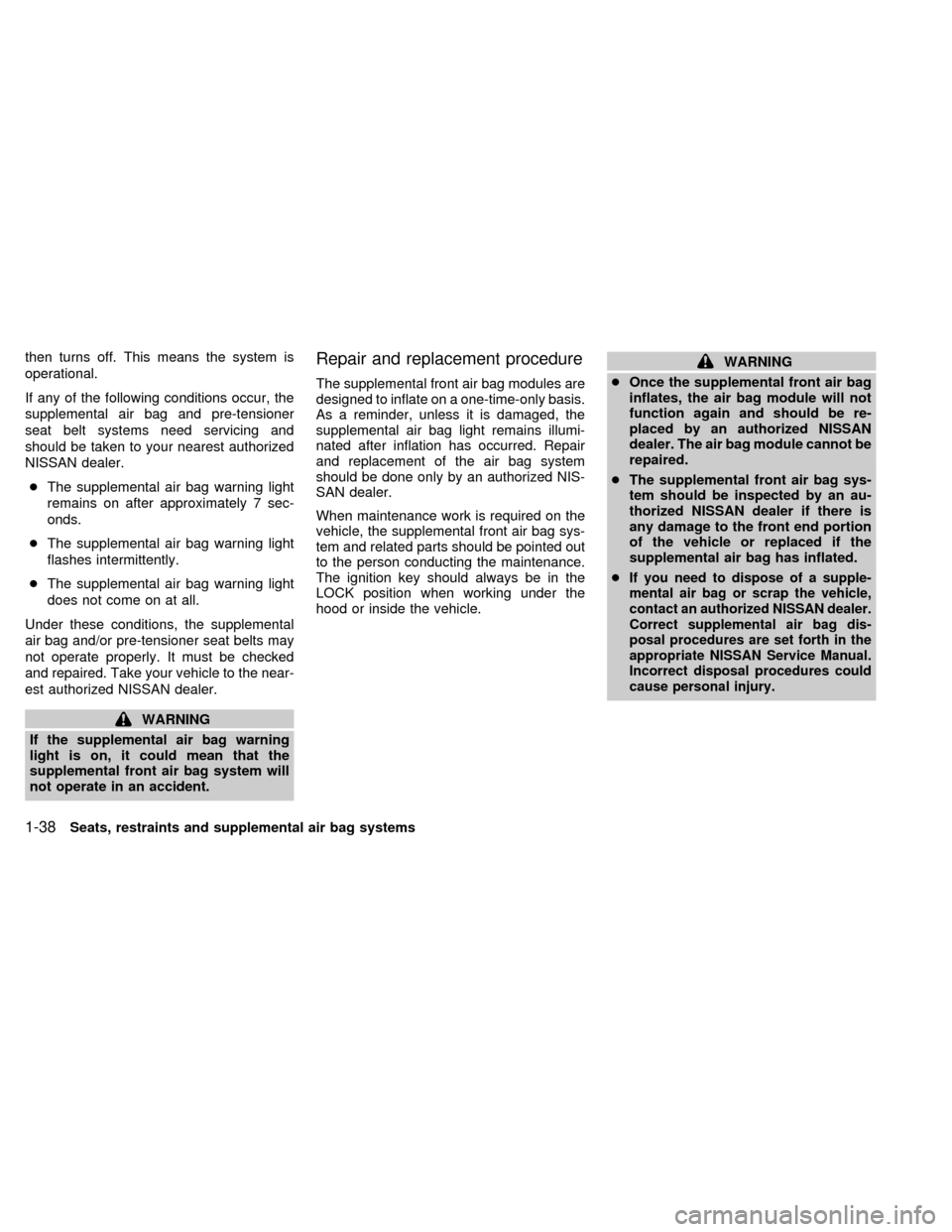
then turns off. This means the system is
operational.
If any of the following conditions occur, the
supplemental air bag and pre-tensioner
seat belt systems need servicing and
should be taken to your nearest authorized
NISSAN dealer.
cThe supplemental air bag warning light
remains on after approximately 7 sec-
onds.
cThe supplemental air bag warning light
flashes intermittently.
cThe supplemental air bag warning light
does not come on at all.
Under these conditions, the supplemental
air bag and/or pre-tensioner seat belts may
not operate properly. It must be checked
and repaired. Take your vehicle to the near-
est authorized NISSAN dealer.
WARNING
If the supplemental air bag warning
light is on, it could mean that the
supplemental front air bag system will
not operate in an accident.
Repair and replacement procedure
The supplemental front air bag modules are
designed to inflate on a one-time-only basis.
As a reminder, unless it is damaged, the
supplemental air bag light remains illumi-
nated after inflation has occurred. Repair
and replacement of the air bag system
should be done only by an authorized NIS-
SAN dealer.
When maintenance work is required on the
vehicle, the supplemental front air bag sys-
tem and related parts should be pointed out
to the person conducting the maintenance.
The ignition key should always be in the
LOCK position when working under the
hood or inside the vehicle.
WARNING
cOnce the supplemental front air bag
inflates, the air bag module will not
function again and should be re-
placed by an authorized NISSAN
dealer. The air bag module cannot be
repaired.
cThe supplemental front air bag sys-
tem should be inspected by an au-
thorized NISSAN dealer if there is
any damage to the front end portion
of the vehicle or replaced if the
supplemental air bag has inflated.
c
If you need to dispose of a supple-
mental air bag or scrap the vehicle,
contact an authorized NISSAN dealer.
Correct supplemental air bag dis-
posal procedures are set forth in the
appropriate NISSAN Service Manual.
Incorrect disposal procedures could
cause personal injury.
1-38Seats, restraints and supplemental air bag systems
ZX
Page 47 of 294
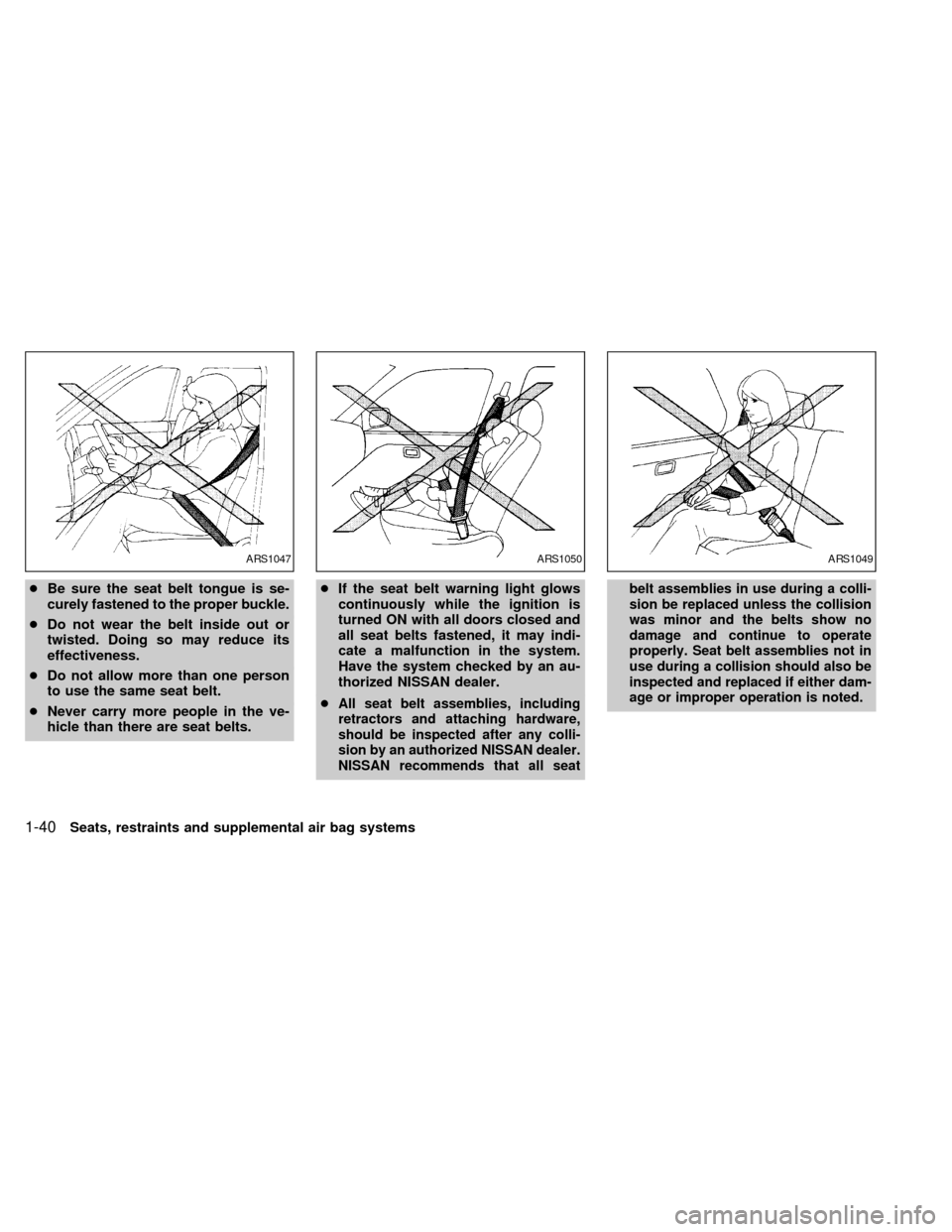
cBe sure the seat belt tongue is se-
curely fastened to the proper buckle.
cDo not wear the belt inside out or
twisted. Doing so may reduce its
effectiveness.
cDo not allow more than one person
to use the same seat belt.
cNever carry more people in the ve-
hicle than there are seat belts.cIf the seat belt warning light glows
continuously while the ignition is
turned ON with all doors closed and
all seat belts fastened, it may indi-
cate a malfunction in the system.
Have the system checked by an au-
thorized NISSAN dealer.
c
All seat belt assemblies, including
retractors and attaching hardware,
should be inspected after any colli-
sion by an authorized NISSAN dealer.
NISSAN recommends that all seatbelt assemblies in use during a colli-
sion be replaced unless the collision
was minor and the belts show no
damage and continue to operate
properly. Seat belt assemblies not in
use during a collision should also be
inspected and replaced if either dam-
age or improper operation is noted.
ARS1047ARS1050ARS1049
1-40Seats, restraints and supplemental air bag systems
ZX
Page 92 of 294

1. Horn
2. Meters/gauges
3. Gear shift selector lever
4. Hazard warning flasher switch
5. Rear window washer switch
6. Rear window wiper switch
7. Rear window defogger switch
8. Security light
9. Center ventilators
10. Passenger supplemental air bag
11. Side ventilator
12. Glove box
13. FM-AM radio with cassette player
14. FM-AM radio with cassette player and
CD player
15. Map pocket (if so equipped)
16. Heater/air conditioner controls
17. Storage compartment
18. Cup holders
19. CD changer (if so equipped)20. Cigarette lighter (accessory)
21. Audio controls
22. Ignition switch/steering lock
23. Driver supplemental air bag
24. Tilt steering lock lever
25. Parking brake
26. Hood release lever
27. Fuse box cover
28. Cruise control main and set switch
29. Front fog light switch
30. Windshield wiper/turn signal/high beam
switch
31. Headlight control switch
32. Instrument brightness control
Instruments and controls
2-3
ZX
Page 94 of 294
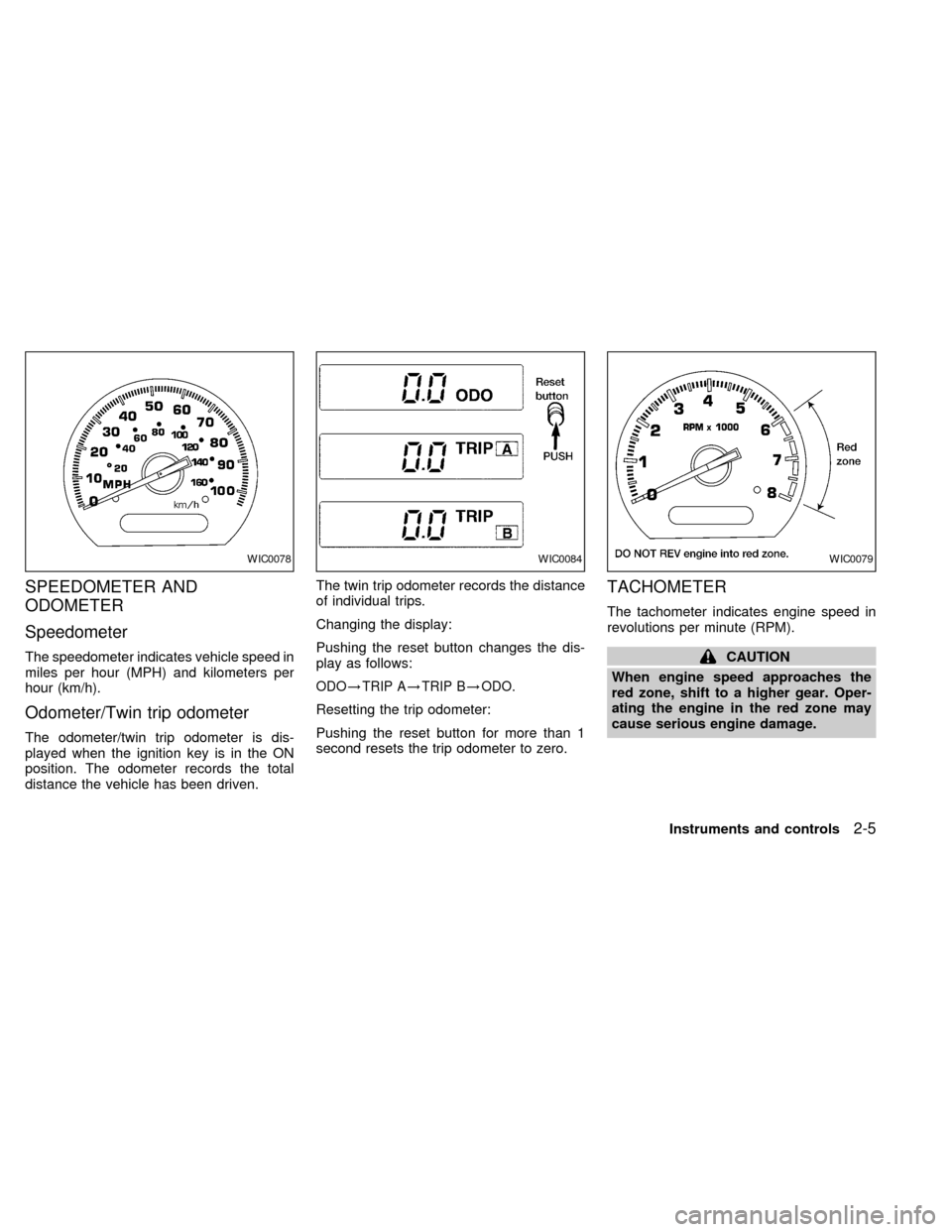
SPEEDOMETER AND
ODOMETER
Speedometer
The speedometer indicates vehicle speed in
miles per hour (MPH) and kilometers per
hour (km/h).
Odometer/Twin trip odometer
The odometer/twin trip odometer is dis-
played when the ignition key is in the ON
position. The odometer records the total
distance the vehicle has been driven.The twin trip odometer records the distance
of individual trips.
Changing the display:
Pushing the reset button changes the dis-
play as follows:
ODO!TRIP A!TRIP B!ODO.
Resetting the trip odometer:
Pushing the reset button for more than 1
second resets the trip odometer to zero.
TACHOMETER
The tachometer indicates engine speed in
revolutions per minute (RPM).
CAUTION
When engine speed approaches the
red zone, shift to a higher gear. Oper-
ating the engine in the red zone may
cause serious engine damage.
WIC0078WIC0084WIC0079
Instruments and controls2-5
ZX
Page 95 of 294
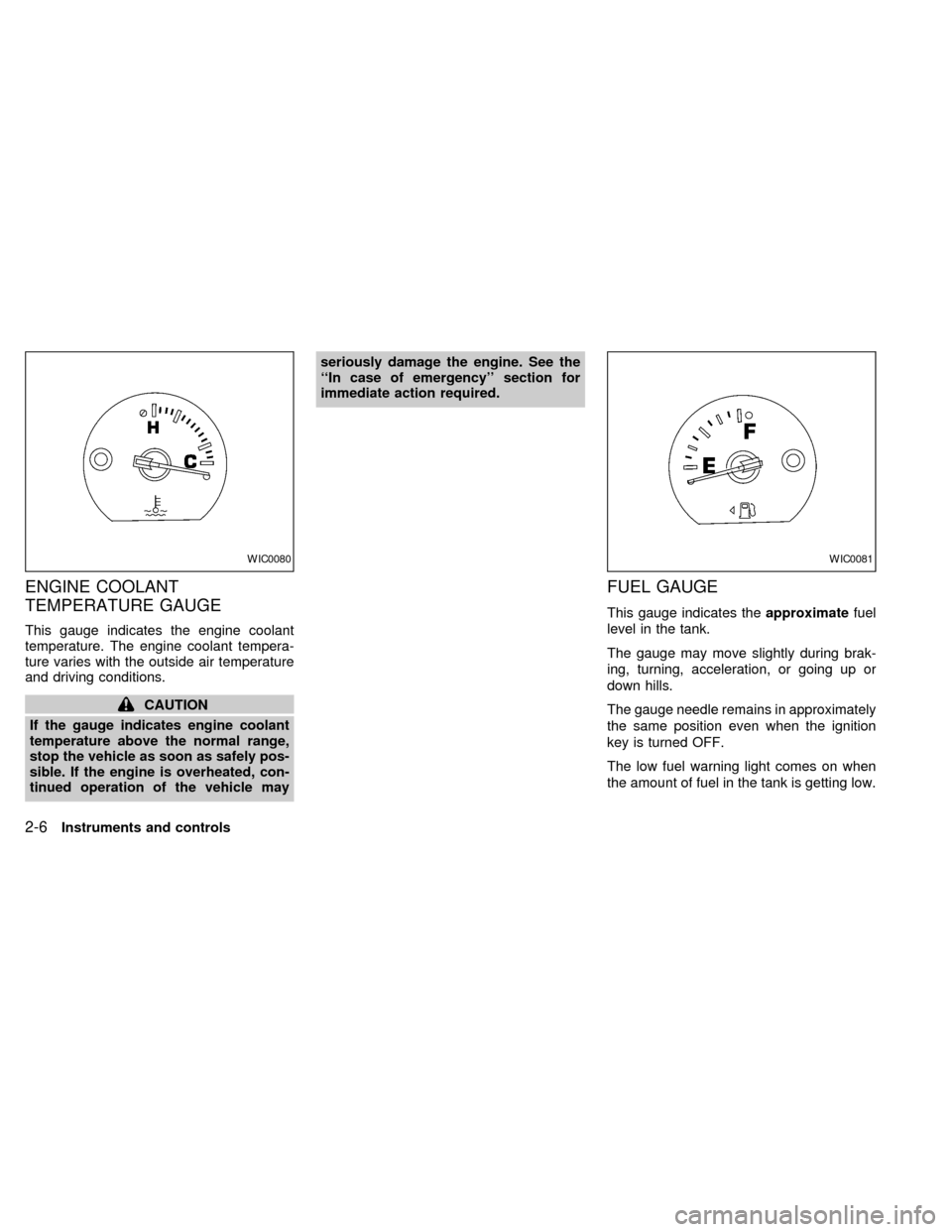
ENGINE COOLANT
TEMPERATURE GAUGE
This gauge indicates the engine coolant
temperature. The engine coolant tempera-
ture varies with the outside air temperature
and driving conditions.
CAUTION
If the gauge indicates engine coolant
temperature above the normal range,
stop the vehicle as soon as safely pos-
sible. If the engine is overheated, con-
tinued operation of the vehicle mayseriously damage the engine. See the
``In case of emergency'' section for
immediate action required.
FUEL GAUGE
This gauge indicates theapproximatefuel
level in the tank.
The gauge may move slightly during brak-
ing, turning, acceleration, or going up or
down hills.
The gauge needle remains in approximately
the same position even when the ignition
key is turned OFF.
The low fuel warning light comes on when
the amount of fuel in the tank is getting low.
WIC0080WIC0081
2-6Instruments and controls
ZX
Page 96 of 294

Refill the fuel tank before the gauge
registers E (empty).
CAUTION
cIf the vehicle runs out of fuel, the
malfunction indicator lamp
(MIL) may come on. Refuel as soon
as possible. After a few driving trips,
the
lamp should turn off. If the
lamp remains on after a few driving
trips, have the vehicle inspected by
an authorized NISSAN dealer.
cFor additional information, see the
``Malfunction indicator lamp (MIL)''
later in this section.
The message center only works with the
ignition in the ON position.
The message center displays the following
information:
cOutside air temperature
cAverage fuel economy
cDistance to empty
You can select the different features by
pushing the message center reset button.
Outside air temperature
Press the message center reset button until
the outside air temperature is displayed.
The outside air temperature sensor is
located in front of the radiator. The sen-
sor may be affected by road or engine
heat, wind direction and other driving
conditions. The display may differ from
the actual outside temperature or the
temperature displayed on various signs
or billboards.
Average fuel economy
Press the message center reset button until
fuel economy is displayed. Fuel economy is
displayed in liters/100 km or miles/gallon.
Your vehicle must be moving to calculate
fuel economy. Fuel economy is averaged
from the last reset. To reset, hold down the
reset button momentarily.
Distance to empty
This will display how many kilometers or
miles you can drive until you run out of fuel.
To ensure accuracy, turn the ignition off
when you fill the fuel tank.
WIC0083
MESSAGE CENTER (if so
equipped)
Instruments and controls2-7
ZX
Page 97 of 294
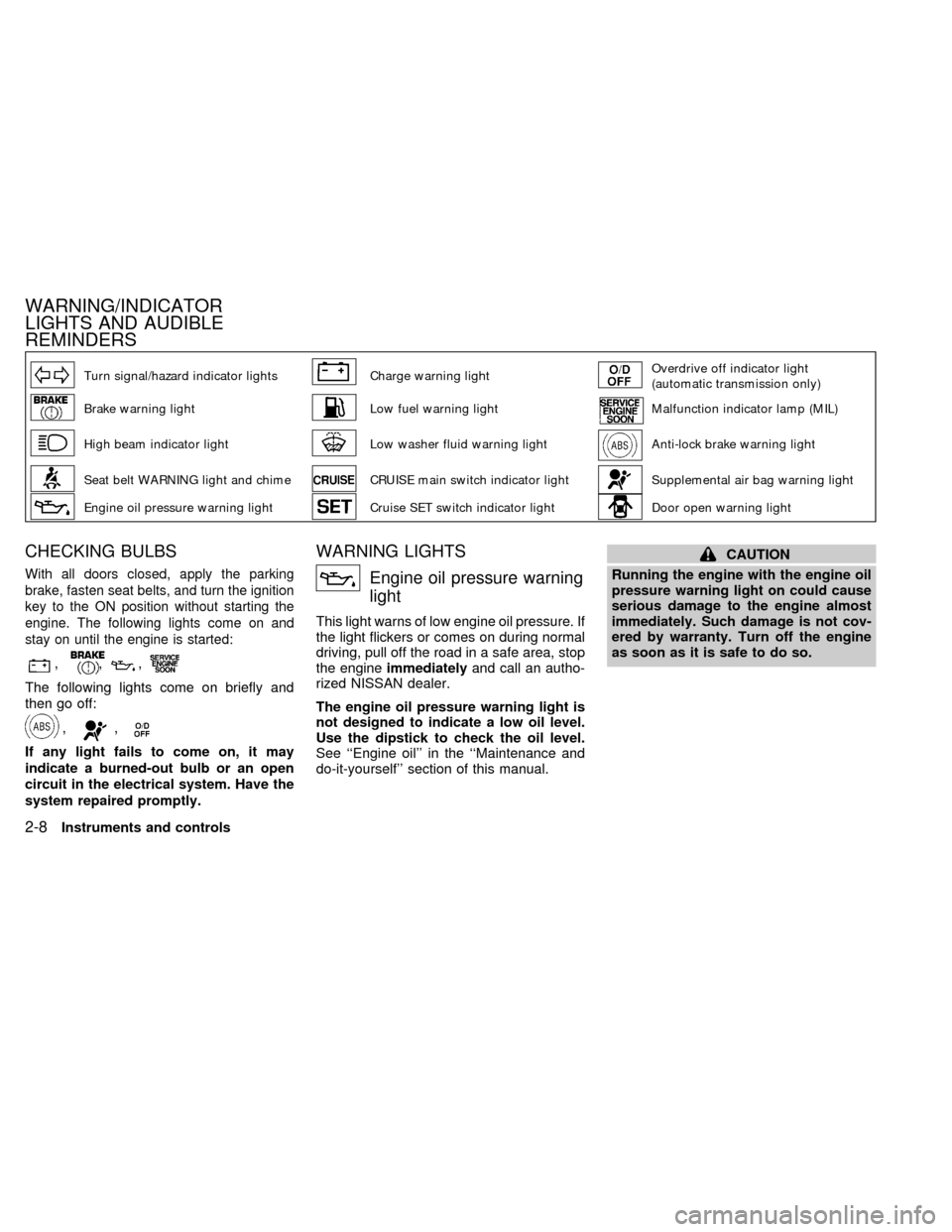
Turn signal/hazard indicator lightsCharge warning lightOverdrive off indicator light
(automatic transmission only)
Brake warning lightLow fuel warning lightMalfunction indicator lamp (MIL)
High beam indicator lightLow washer fluid warning lightAnti-lock brake warning light
Seat belt WARNING light and chimeCRUISE main switch indicator lightSupplemental air bag warning light
Engine oil pressure warning lightCruise SET switch indicator lightDoor open warning light
CHECKING BULBS
With all doors closed, apply the parking
brake, fasten seat belts, and turn the ignition
key to the ON position without starting the
engine. The following lights come on and
stay on until the engine is started:
,,,
The following lights come on briefly and
then go off:
,,
If any light fails to come on, it may
indicate a burned-out bulb or an open
circuit in the electrical system. Have the
system repaired promptly.
WARNING LIGHTS
Engine oil pressure warning
light
This light warns of low engine oil pressure. If
the light flickers or comes on during normal
driving, pull off the road in a safe area, stop
the engineimmediatelyand call an autho-
rized NISSAN dealer.
The engine oil pressure warning light is
not designed to indicate a low oil level.
Use the dipstick to check the oil level.
See ``Engine oil'' in the ``Maintenance and
do-it-yourself'' section of this manual.
CAUTION
Running the engine with the engine oil
pressure warning light on could cause
serious damage to the engine almost
immediately. Such damage is not cov-
ered by warranty. Turn off the engine
as soon as it is safe to do so.
WARNING/INDICATOR
LIGHTS AND AUDIBLE
REMINDERS
2-8Instruments and controls
ZX